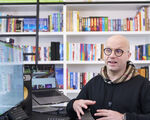There's no sugar coating it: Creative thinking is not as easy as multiple online gurus present it to be. As an event professional, you must be familiar with the challenges that come with brainstorming new solutions.
Sure, there are a million articles out there that give you advice on how to improve your creativity, but the truth of the matter is that it’s not always easy to come up with a wide range of fresh ideas that will actually work.
It can be quite frustrating when you're searching for quick answers to different event-planning issues by getting everybody in a meeting room and demanding new creative perspectives. And this task becomes harder if you want to test ad-hoc solutions or ideas.
In his article 'Creativity is overrated', Eliot Gattegno, a clinical professor of Business and Arts at NYU Shanghai, highlights "While 'creativity' is presented as the panacea for our overly cubicled society, this often leads to a narrow-minded focus on the stuff that dreams are made of—to the detriment of those keeping the company afloat."
Gattegno explains, "Almost any creative project has an incredible amount of training and effort behind it, no matter how instantaneous it may seem." Yet, you don't have the time to 'train' yourself or your team to become creative problem-solvers. There are too many other fires to extinguish.
In addition, you need to find (and test!) new event solutions right away. No worries - we have your back. Here's how you can do it:
Apply a systematic approach
The main goal of systematic approach is to discover the most efficient and easy way to improve a situation. Before a team brainstorming session, ask yourself why you’re looking for new solutions in the first place.
What issues or problems are you trying to solve? What aspects of your event would you like to optimize? When applying a systematic approach, you can define the steps and goals you want to achieve by generating new ideas.
For example, you may want to create a better online registration form. Instead of encouraging your team members to launch ideas during a brainstorming session, work together to identify the reasons you want to change the form, what goals you are pursuing, and what results an improved form will generate.
By defining the problem as well as the desired outcomes, you'll stimulate an efficiency-driven approach, this way providing a well-defined framework for new solutions.
Learn how to conduct idea screenings
You don't have to invent the wheel each time you search for new solutions. Chances are that somebody else before you had the same issues and came up with powerful ideas to solve it. When conducting an idea screening, you can ask other event professionals (face-to-face or online) about the new ideas they've applied to overcome an event-related challenge. You can also look online for inspiring articles and posts and 'borrow' some event-related problem-solving ideas.
Run feasibility tests
The most efficient way to see if your proposed solutions that will work is to run a practicality test. Of course, you won't be able to test every single solution. For example, you can't predict your audience’s reaction to new live engagement practice until the actual event.
But if your intention is to test the changes you made while building a new event website, you can easily run A/B testing and decide if the new page structure, architecture, or copy has a greater impact on the number of attendee registrations than the old one.
Pick each individual team member's brain
Collective brainstorming is not always the best option. According to neuroscientist Andrew Tate, if you had think about "the worst way to get people to come up with plentiful, unique, imaginative ideas—then brainstorming would probably fit that bill."
In a different article, Tate argues, "The more extrovert and assured members of the group assert their ideas first and then those less confident agree, even if they might have equally sound ideas."
That's why you may want to schedule one-on-one meetings with each individual team member to discuss different event-planning or marketing aspects that you need to improve. People will feel less intimidated to express their thoughts in an individual setting, plus you can have an in-depth work session with them, increasing the chances of finding relevant solutions and new ideas.
Foresee the impact of your actions
When it comes to implementing and testing new ideas, always consider the way things may turn out. This will help you avoid some surprises and understand the wide range of effects a new idea may have on your event. Moreover, it will enable you to find solutions to possible problems. For example, if you decided to have a multi-track event and offer gifts at the entrance of each room, by projecting the potential outcomes, you might realize you'll need to find a solution so that people only need to check in just once, and respectively receive one gift only.
Wrap-up
Don't stress if you don't feel creative enough to find new event-related solutions. Instead of applying creative thinking, you can always use a series of techniques that will help you identify your problems, understand what your desirable outcomes are, and find the best new solutions for your upcoming events.






